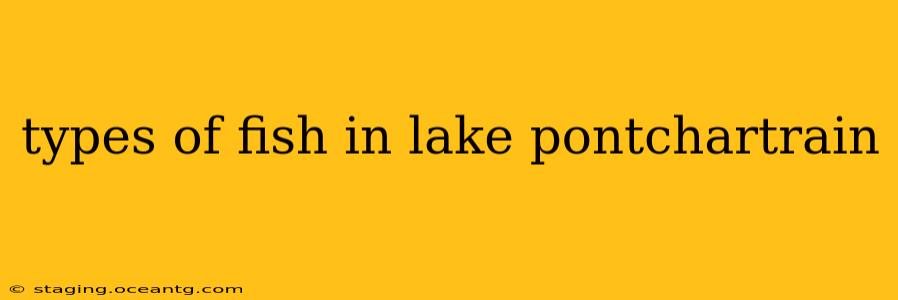Lake Pontchartrain, a large brackish lake in southeastern Louisiana, boasts a diverse ecosystem teeming with various fish species. Understanding the types of fish found in this unique environment is crucial for both recreational anglers and those interested in the lake's ecological health. This guide explores the common and notable fish inhabiting Lake Pontchartrain, addressing frequently asked questions about its aquatic life.
What kinds of fish are in Lake Pontchartrain?
Lake Pontchartrain's brackish water—a mix of freshwater and saltwater—supports a fascinating array of fish. Some of the most prevalent species include:
- Redfish (Red Drum): A popular game fish known for its powerful fight and delicious meat. Lake Pontchartrain supports a healthy population, particularly in the more saline areas.
- Speckled Trout (Spotted Seatrout): Another highly sought-after game fish, speckled trout are prized for their delicate flavor and are common throughout the lake, especially in areas with grass beds.
- White Trout (Gulf Flounder): A bottom-dwelling fish, the white trout is a common catch in Lake Pontchartrain. They are adept at camouflage and blend well with the lake's bottom.
- Black Drum: These large, bottom-feeding fish are a significant part of the Lake Pontchartrain ecosystem. They are less common than redfish or speckled trout but still provide a rewarding catch.
- Sheepshead: Found in areas with structure such as pilings and oyster reefs, sheepshead are known for their strong jaws and ability to crush shellfish.
- Croaker: These fish are abundant in the lake and are recognized by their distinctive croaking sound. They are a popular target for anglers using bottom-fishing techniques.
- Menhaden (Pogey): These small, oily fish are a vital part of the food chain in Lake Pontchartrain. While not typically targeted by recreational anglers, they serve as a significant food source for larger predatory fish.
- Various Mullet Species: Mullet are a common sight in the lake, playing a crucial role in the ecosystem. They are often found in shallow, nearshore areas.
What is the most common fish in Lake Pontchartrain?
While the exact proportions fluctuate seasonally, menhaden (pogey) and various mullet species likely represent the most abundant fish in Lake Pontchartrain due to their role as forage fish. However, speckled trout and redfish are arguably the most popular fish among recreational anglers because of their sporting qualities and culinary appeal.
Is there bass in Lake Pontchartrain?
While Lake Pontchartrain isn't primarily known for its bass population, small numbers of largemouth bass can be found in some of the fresher, more inland areas of the lake. However, the brackish nature of most of the lake isn't ideal for large, thriving bass populations.
What kind of fish are caught in Lake Pontchartrain in the winter?
During winter months, when water temperatures drop, some species become less active. However, you can still expect to catch speckled trout, redfish, and black drum, albeit possibly in smaller numbers and requiring different fishing techniques adapted to cooler water conditions. Targeting deeper areas may prove more fruitful during winter.
Is fishing good in Lake Pontchartrain?
Lake Pontchartrain offers excellent fishing opportunities, especially for anglers targeting saltwater species. The abundance of speckled trout, redfish, and other species attracts many fishermen throughout the year. However, fishing success depends on factors like weather conditions, season, and fishing technique.
What is the best bait for fishing in Lake Pontchartrain?
The best bait in Lake Pontchartrain varies depending on the target species and time of year. Popular choices include live shrimp, artificial lures mimicking baitfish (like MirrOlures or spoons), and crab. Experimentation is key to finding what works best on a given day.
Disclaimer: This information is intended for educational purposes. Always check current fishing regulations and obtain the necessary licenses before fishing in Lake Pontchartrain. Conditions can change, so local knowledge and up-to-date reports are advisable for optimal fishing success.
